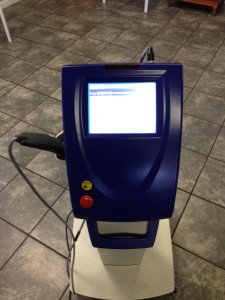Uncategorized
Top Ten Foods To NOT Give Your Pet
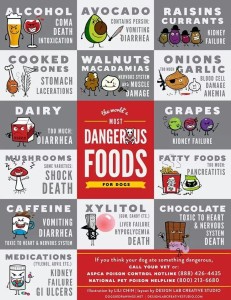 We often think of our pets as one of the family, which is what they are. But they are not human. Foods that are safe for us may not be safe for our pets and could be toxic to our furry friends. They have allergies just like we do. We need to be aware of what foods to avoid giving to our pets. In general, we are told not to give human food to our cats, dogs, birds, and rodents. This means no table scraps, though most of us are guilty of saving a piece of meat or some potato chips for Tabitha or Fido. We are conditioned to look into those pleading eyes and give in.
We often think of our pets as one of the family, which is what they are. But they are not human. Foods that are safe for us may not be safe for our pets and could be toxic to our furry friends. They have allergies just like we do. We need to be aware of what foods to avoid giving to our pets. In general, we are told not to give human food to our cats, dogs, birds, and rodents. This means no table scraps, though most of us are guilty of saving a piece of meat or some potato chips for Tabitha or Fido. We are conditioned to look into those pleading eyes and give in.
In general, nature eliminates toxic foods before they can do harm by vomiting and diarrhea, before they can be absorbed and cause serious illness. If you suspect your pet has eaten any type of toxic food, please note the amount ingested and contact your veterinarian. Below are my top ten foods not to give your pet.
Chocolate, Coffee, and Caffeine
You probably already know not to feed your dog chocolate, but it is worth mentioning anyway. Chocolate, caffeine, and coffee poisoning in dogs occurs because of a chemical called theobromine, a substance which dogs can overdose on by eating chocolate. If your pet ingests too much of these, they can have severe vomiting and diarrhea, panting excessive thirst and urination, hyperactivity, abnormal heart rhythm, seizures and even death. The dark and baking chocolates contain more theobromine, so are more dangerous than the milk or white chocolates. The average American needs caffeine infused coffee to survive, but this is not true for dogs.
Grapes and Raisins
Grapes and raisins were once thought to be a good treat for dogs—not anymore. Since grapes are such a common people snack, they pose a risk to dogs living in the home. Children munching down on handfuls of raisins may not know that they aren’t doing their pets a favor by sharing. Grapes can cause acute renal failure—a sudden failure of the kidneys—along with vomiting and diarrhea. Scientists still don’t quite know what makes grapes and raisins toxic to dogs.
Macadamia Nuts
Macadamia nuts are the most toxic of all the nuts in dogs and cats. These famous Hawaiian nuts are considered toxic to dogs because they tend to cause gastrointestinal upsets, lethargy, vomiting, and muscle tremors or stiffness. As few as six nuts can cause severe poisoning. Macadamia nuts and walnuts are toxic to dogs, and these can trigger pancreatitis.
Alcohol
It goes without saying to not give your pets alcohol. Some people actually get a kick out of getting their pets drunk. Even small amount of alcohol can be devastating to a pet. To do this intentional is animal abuse. Alcoholic beverages and food products containing alcohol can cause vomiting, diarrhea, decreased coordination, central nervous system depression, difficulty breathing, tremors,, abnormal blood acidity, coma and even death.
Onions and Garlic
Onions, garlic, scallions and shallots contain disulfide, a compound that can damage dogs’ red blood cells. When dogs eat raw onions or garlic, they risk developing hemolytic anemia, which occurs when destroyed red blood cells cannot be replaced. Eating powdered forms of onion or garlic in soups, dips, or sauces is also toxic. Signs or internal damage, such as weakness, orange-colored urine, tiring easily or resisting movement, may not appear for a few days. If you notice these symptoms, immediately take your dog to a veterinarian or emergency clinic where a blood transfusion may be necessary.
Baking Dough
Uncooked break dough that contains yeast can be dangerous for any dog who ingests it. The stomach’s moist warm environment makes it perfect for the yeast in raw dough to rise, which can cause intense discomfort and lead to the dog’s stomach or bowel to rupture. The expanding stomach can press against the dog’s diaphragm, making breathing difficult. If your dog has eaten bread dough, she needs to be examined by a veterinarian immediately.
Avocado
Avocados contain a chemical called Persin which is poisonous to birds and cattle and there have been some reports of dogs getting sick from avocados. It is included on my “thou shalt not” list, because it can lead to diarrhea and vomiting. The giant seed is also a choking hazard, so keep your dog our of the garbage or off the counter. If swallowed, it can block the digestive tract and require emergency surgery.
Xylitol
Xylitol is a sweetening agent used in sugar-free gum and candy, and as a sweetener added to sugar-free baked goods. Products containing xylitol should never be given to or within reach of dogs. Symptoms of xylitol poisoning include vomiting, lethargy, loss of coordination, erratic behavior, disorientation and seizures. Eating candy, gum or baked foods made with xylitol can cause a severe drop in blood-sugar levels, resulting in liver failure. As always, if you suspect that your pet has ingested xylitol, you should contact your veterinarian immediately.
Fatty Foods
Dogs are fond of meat and other high-fat foods, but cooked and uncooked meat table scraps and fat trimmed from meat can cause pancreatitis. Unfortunately, some people treat dogs with leftovers, and dogs sometimes treat themselves by stealing food. Pancreatitis in dogs often follows the consumption of a fatty meal or snack. Your dog may become very sick quickly, and if you notice symptoms such as vomiting, diarrhea and abdominal pain, it should be examined immediately and receive intensive fluid and antibiotic therapy.
Milk
Abdominal cramps and diarrhea are the usual symptoms and maybe severe. Adult dogs and cats are lactose-intolerant. They don’t have sufficient amounts of the enzyme lactase, which breaks down the lactose in milk. It isn’t even recommended to give cow’s milk to puppies and kittens.
This list is only a sampling of foods that can be toxic to your pet. But my best advice is that if you think that it could be bad, don’t feed it to your pet. And of course, contact me if you have any questions.
February Is National Spay Or Neuter Your Pet Month
 Whether you’ve recently adopted or are considering it, one of the most important health decisions you will make is to spay or neuter them. Spaying and neutering your pets offer lifelong benefits, improves your pets behavior and keeps them close to home. So in keeping with this theme, I am offering my top ten reasons to spay or neuter your pet.
Whether you’ve recently adopted or are considering it, one of the most important health decisions you will make is to spay or neuter them. Spaying and neutering your pets offer lifelong benefits, improves your pets behavior and keeps them close to home. So in keeping with this theme, I am offering my top ten reasons to spay or neuter your pet.
- Spaying your pet saves lives. An unspayed female cat and her mate will produce 2 litters per year with 2.8 kittens surviving per litter. After 2 years, that pair could be responsible for 67 offspring. Likewise an unspayed dog, her mate and puppies could produce about 128 puppies in 2 years.
- Your female pet will live a longer, healthier life. Spaying helps prevent uterine infections and breast cancer. Those female dogs that are spayed prior to their first heat cycle can have an incidence of .05% for breast cancer. If they are spayed after their first heat cycle, that incidence increases to 18% and after the second heat cycle, the incidence is increased to 26%.
- Neutering provides major health benefits for your male. Besides preventing unwanted litters, neutering your male companion prevents testicular cancer, if done before six months of age.
- By spaying your female, your pet won’t go into heat. By not going into heat, you won’t need to experience the yowling, frequent urination, and abnormal behavioral pattern in your cat. Your dog won’t have that unwanted discharge for a period of an average of 3 weeks.
- Your male dog will be less likely to roam. A male dog will do almost anything to find a mate. That includes digging his way under the fence and making like Houdini to escape from the house. And once he is free to roam, he risks injury in traffic and fights with other dogs.
- Altered males and females will be better behaved and less aggressive. The dogs will be more affectionate and focus their attention more on their human families. On the other hand, unneutered dogs and cats may mark their territory by spraying strong-smelling urine all over the house.
- Spaying and neutering your pet will not make them fat. Pets get fat because of lack of exercise and overfeeding. Your pet will remain fit and trim as long as you continue to provide exercise and monitor food intake.
- By spaying and neutering your pets, you create a safer neighborhood. Strays cause problems in the community by preying on wildlife, cause traffic accidents and scare children. It will also help reduce the number of animals on the streets.
- There are NO benefits to letting your pet have a litter. Many pet owners think that their dog is special and unique. The fact is that the shelters are full of special and unique pets. By allowing your children to witness your pet birth, you are teaching your children to be irresponsible.
- Just because you have a purebred doesn’t mean it should be bred. In fact, 25% of the dogs in the shelters are purebred, not including those in the rescue groups.
Extra tip!
- If you get or are getting a new addition to the family, I highly recommend that you consider spaying and neutering your pet because of the previous reasons. The cost is a lot less than having and caring for a litter. It also beats the costs of treatments from cat and dog fights that might be necessary due to them being still intact.
For more information on spaying and neutering, don’t hesitate to contact our office today!
Training A New Puppy?
 Many people might have acquired a new addition to their family over the holidays-namely a new puppy. Training is probably the single most important step in raising your puppy to make ownership a positive experience.
Many people might have acquired a new addition to their family over the holidays-namely a new puppy. Training is probably the single most important step in raising your puppy to make ownership a positive experience.
This training includes puppy crate training. Puppy crate training is a fantastic method of managing the safety and well-being of young puppies. When used properly, the crate is an invaluable tool for establishing good habits in your puppies and also for preventing problem behaviors before they arise. In spite of what you may think or have read about puppy crate training, the truth is that we crate train puppies for their benefit – that is why we do it.
Over time the crate will become your puppy’s own private area for which they will grow to love and feel secure in. You will come to rely on your crate to supply many important benefits such as puppy housebreaking and establishing good habits along with preventing destructive habits which we can rectify. Another benefit from crating your puppy include protecting it from dangerous household items such as wires, poisons and foreign objects.
Proper use of the crate can help reduce the chance of your puppy developing separation anxiety. Separation anxiety is becoming a huge problem for an increasingly large percentage of dogs. The crate will become a place where your dog is calm, out of trouble and accustomed to being alone.
When puppy crate training is applied correctly, your puppy cannot get into any mischief which significantly reduces any need to discipline it. Also it makes trips and stays such as to your veterinarian or dog groomer a more bearable experience. This makes for a far better environment in which to live for both the dog and the owner.
Besides the crate, I recommend that the puppy is provided with a nice comfortable dog bed or blanket in the crate that cannot be destroyed or chewed up. Some chew toys that will keep the puppy occupied when in the crate, and a good clean supply of water. It is best to have the water in a bowl that has a heavy wide base to prevent spillage in the cage.
In introducing your puppy to the crate, it is important that your puppy’s first impression and experiences with the crate are not traumatic. We need to set it up so that your puppy views the crate as a positive object right from the start. Your goal is for your puppy to love the crate and choose to use it rather than as a contraption it associates with isolation and loneliness.
I am going to offer a few tips that may make the crate more inviting to your puppy, But remember, always take it slow. It may work best to put the crate in the room with you and leave the door open wide to start out. A central room or a large hallway may work best.
- Occasionally throughout the day, drop small pieces of kibble or dog biscuits in the crate. While investigating his new crate, the pup will discover edible treasures, thereby reinforcing his positive associations with the crate. You may also feed him in the crate to create the same effect. If the dog hesitates, it often works to feed him in front of the crate, then right inside the doorway and then finally, in the back of the crate.
- In the beginning, praise and pet your pup when he enters. Do not try to push, pull, or force the puppy into the crate. At this early stage of introduction only inductive methods are suggested. Overnight exception: You may need to place your pet in his crate and shut the door upon retiring. (In most cases, the crate should be placed right next to your bed overnight. If this is not possible, the crate can be placed in a kitchen, bathroom or living room.)
- You may also play this enjoyable and educational game with your pup or dog: without alerting your puppy, drop a small biscuit into the crate. Then call your puppy and say to him, “Where’s the biscuit? It’s in your room.” Using only a friendly, encouraging voice, direct your pup toward his crate. When the puppy discovers the treat, give enthusiastic praise. The biscuit will automatically serve as a primary reward. Your pup should be free to leave its crate at all times during this game. Later on, your puppy’s toy or ball can be substituted for the treat.
- It is advisable first to crate your pup for short periods of time while you are home with him. In fact, crate training is best accomplished while you are in the room with your dog. Getting him used to your absence from the room in which he is crated is a good first step. This prevents an association being made with the crate and your leaving it alone.
One thing that you NEVER want to do is to use the crate as a tool for punishment. This causes the puppy to fear and resent the crate. If your puppy is correctly introduced to its crate, your puppy should be happy to go into the crate anytime.
Dog crates give your dog a place that he can claim as his territory. We just want to make sure it doesn’t interfere with yours. Providing your puppy with a comfortable room of his own will help keep it off furniture. In addition to the safety and comfort benefits, it will help minimize you and your puppy’s frustrations.
For any questions, just give us a call. We can’t wait to meet your newest addition!
Chocolate Is Not For Everyone During The Holidays..
 Dogs are known for eating things when they are not supposed to. No responsible pet owner would ever intentionally feed their pup chocolate, but sometimes these furry scalawags sneak the forbidden snack right off the counter. This is especially true of puppies.
Dogs are known for eating things when they are not supposed to. No responsible pet owner would ever intentionally feed their pup chocolate, but sometimes these furry scalawags sneak the forbidden snack right off the counter. This is especially true of puppies.
Dogs have an excellent sense of smell, making it fairly easy to find any secret hiding spots for the chocolate. This can be a dangerous combination which could lead to a trip to your veterinarian—or worse the ER.
Chocolate is derived from the roasted seeds of the theobroma cacao, which contain certain properties that can be toxic to animals: caffeine and theobromine. If ingested, these two ingredients can also lead to various complications such as vomiting and diarrhea to rapid heart rates to coma, seizures and possible death.
A single piece of chocolate or a small amount will probably not be a problem because it doesn’t contain enough theobromine to harm your dog, however if your dog has eaten a whole box of chocolates, you need to call your veterinarian immediately. Do not wait.
When it comes to chocolate, it is imperative to remember this fact: Dark=dangerous! The darker the chocolate, the larger amount of theobromine it contains. Thus, baker’s chocolate, semi-sweet chocolate, cocoa powder and gourmet dark chocolates are more dangerous than milk chocolate and white chocolate has very little theobromine and will not cause chocolate poisoning in pets.
If your pet has ingested chocolate, it is important to induce vomiting and give multiple doses of activated charcoal to decontaminate . Aggressive IV fluids to help with the excretion of the toxin and sedatives to calm your pet and slow down the heart rate. The best treatment is to get your dog to your veterinarian immediately.
Of course, never consider chocolate as a reward. Always provide healthy treats or simply reward your dog with lots of love and attention. For more information, you can contact us via email or schedule an appointment if you think your furry friend has gotten a hold of some chocolate!
Signs Your Pet May Have Diabetes
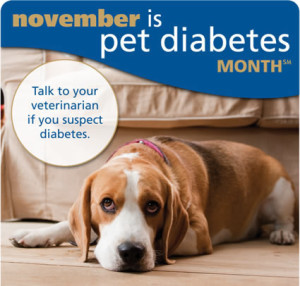 November has been designated Pet Diabetes Month to bring awareness to diabetes in our four-legged friends. Estimates vary, but it is believed that 2 percent and about 1 in every 160 dogs develops diabetes. Many owners are not aware that their dogs or cats can develop the disease or even what the symptoms of diabetes are among pets.
November has been designated Pet Diabetes Month to bring awareness to diabetes in our four-legged friends. Estimates vary, but it is believed that 2 percent and about 1 in every 160 dogs develops diabetes. Many owners are not aware that their dogs or cats can develop the disease or even what the symptoms of diabetes are among pets.
Diabetes has no cure, but can be managed successfully so that your cat or dog can live a full and happy life.
There are several clinical signs that may suggest that your pet is affected. These may include excessive water consumption, frequent urination, veracious appetite but does not gain weight, lethargy, cloudy eyes, or a dry, dull, or thinning hair coat.
When you bring your pet to the veterinarian, they will ask you about any signs or symptoms that you have noticed, how long they have been occurring, and which medications or supplements that your pet is taking. The veterinarian will also check your pet’s general health, determining if there are any infections or other conditions present.
Your veterinarian will check for glucose and ketones in the urine of your pet along with testing the glucose and fructosamine levels in your pet’s blood. Based on the tests, your veterinarian will then be able to set up a treatment protocol that may include insulin injections , diet change and regular exercise.
It is important that your pet’s needs be addressed, because diabetes can lead to kidney problems, nerve problems, and possibly eye problems. Up to 80 percent of the dogs who have diabetes can develop cataracts.
Diabetes is not just a human disease: your four-legged companions can develop the disease as well. With November being Pet Diabetes Month, it is a good time to learn about diabetes, be aware of the clinical signs, and make an appointment as soon as possible with your veterinarian if you observe any indications of the disease.
Pet Obesity Awareness – What You Need To Know
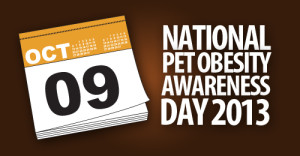 Did you know what the most common nutrition related health condition in dogs is? It is obesity and tens of millions or about 40 percent of the dog population is affected. Fat pets have become the new norm and the sad thing is that most owners are unaware. The primary causes are like humans—being fed too much and not enough exercise.
Did you know what the most common nutrition related health condition in dogs is? It is obesity and tens of millions or about 40 percent of the dog population is affected. Fat pets have become the new norm and the sad thing is that most owners are unaware. The primary causes are like humans—being fed too much and not enough exercise.
The pet owners may notice layers of fat over their pets ribs, along the spine and around the tail. Your pet may have difficulty breathing and have a reduced exercise intolerance. There is a strong relationship in dogs between obesity and diabetes. The early signs of diabetes is the same as people-excessive thirst and urination. With obesity we see several medical problems that could be preventable. These include: heart disease, increased blood pressure, heat intolerance, joint damage and cancer. There can be an increased risk of complications during surgery. The research shows that your pets life can be shortened by 2 to 2 ½ years.
If you think that your pet has an obesity problem, seek your veterinarian’s advice. Because they are the expert in the field. Please don’t do it yourself because your pet’s nutrition and exercise program needs to be monitored closely. Especially in hot weather because of the stress on the heart and lungs.
When setting up a visit with your veterinarian, they will do a physical examination with blood tests. Ideally, the veterinarian will check the heart and lungs and check for signs of hormonal diseases such as hypothyroidism. They will then set up and ideal weight and send home some feeding and exercise guidelines. Initially, I recommend that a follow up visit be made for 4 to 6 weeks. It will probably take several months for your pet to reach its goal.
Pet owners must remember that it will take a family effort in getting everyone on board. It may work best to have only one family member in charge of feeding, but have everyone help exercise. Success can only happen by change, but it will bring healthy results. Which will bring a longer life for your pet.
Your veterinarian will probably recommend a reduced calorie diet. I would recommend that your pet also take a vitamin and mineral supplement to insure that the micro-nutrient and the essential fatty acids requirements are met. It may be good to give some fish oil to maintain good health.
It seems as owners that we tend to take the easy way out and reach into the cookie jar. In the end, living a life in which you prioritize healthy eating and exercise for all members of the family is the key. This means no more treats every time your dog does a trick. If you feel that they need a reward, give them praise and affection.
Join us as we recognize National Pet Obesity Awareness on Wednesday, October 9th this year, and help us prolong the life of your beloved companion.
The Truth About Rabies
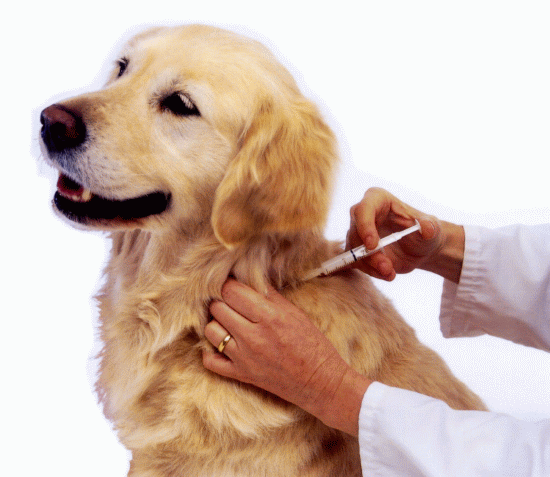 Rabies is a severe and often fatal disease that affects the gray matter of a dog’s brain and its central nervous system. Most generally, the rabies virus is transmitted to dogs through a bite from a diseased carrier like foxes, raccoons, bats, and skunks. Infectious virus particles are retained in a rabid animal’s salivary glands to better spread the virus through their saliva.
Rabies is a severe and often fatal disease that affects the gray matter of a dog’s brain and its central nervous system. Most generally, the rabies virus is transmitted to dogs through a bite from a diseased carrier like foxes, raccoons, bats, and skunks. Infectious virus particles are retained in a rabid animal’s salivary glands to better spread the virus through their saliva.
Once the virus enters the dog’s body, the virus replicates in the muscle and migrates to the nearest nerves. From there, the virus particles travel to the CNS via the fluid within the nerves. The symptoms can take up to a month to develop, but once they have begun, the virus progresses rapidly.
The inflammatory infection can be transmitted to humans, so this is of zoonotic importance.
Many people don’t realize that there are two forms of the disease. There is both a paralytic form and a furious form or a combination of the two. The furious form is the form that has the characteristic hyper-salivating and “mad dog” symptoms, but more times than not, the paralytic form or “dumb rabies” symptoms are present.
The paralytic forms clinical signs are characterized by weakness and loss of coordination, followed by paralysis.
The rabies virus is a fast moving virus, so if your pet is not treated soon after the symptoms appear, the prognosis is very poor. So, if your pet has been bitten by, been in a fight, or in contact with a rabid animal, it is my recommendation that you take your pet to your veterinarian for preventative care immediately
There are many symptoms to watch for in your pets. These include seizures, paralysis, difficulty swallowing, lack of muscular coordination, aggression and excessive excitability.
If you suspect that your pet has rabies, call your veterinarian immediately.
If your pet has been vaccinated, the pet will need to be quarantined for 10 days to monitor for changes in the pets behavior and possible progression of the rabies virus.
The only way to diagnose rabies is by a post-mortem antibody test. So if the pet is showing progressive signs of rabies, the animal will be euthanized and samples of the brain will be sent in to a diagnostic lab for confirmation.
There is no treatment for rabies, so most likely your pet will not survive the disease. Because people can also get rabies, it is of utmost importance that the pet gets prompt attention and the person that is exposed to rabies seeks medical attention immediately.
The Fallacies of Pets & Pet Health
 In my many years in the field of veterinary medicine, I have seen a tremendous number of dogs and cats presented for medical care. As one could imagine, the cases range from the simple and benign to the serious and life threatening. Throughout all of this, I’ve realized that certain problems seem to repeat themselves over and over again, and to be truthful, most problems are preventable with a little forethought, common sense, and knowledge in the proper areas. Thus I have composed a top ten list, if you will, of some of the more usual facts and fallacies that we face on a daily basis. These are in no particular order. I truly hope that you can benefit from them and therefore allow your pet to be happier and healthier from this point forward.
In my many years in the field of veterinary medicine, I have seen a tremendous number of dogs and cats presented for medical care. As one could imagine, the cases range from the simple and benign to the serious and life threatening. Throughout all of this, I’ve realized that certain problems seem to repeat themselves over and over again, and to be truthful, most problems are preventable with a little forethought, common sense, and knowledge in the proper areas. Thus I have composed a top ten list, if you will, of some of the more usual facts and fallacies that we face on a daily basis. These are in no particular order. I truly hope that you can benefit from them and therefore allow your pet to be happier and healthier from this point forward.
1. Pets are overweight because they eat too much. It is that simple. Obesity is the number one health problem today. This problem can cause numerous conditions that can rob your pet of both quality and quantity of life, such as heart and liver disease or musculoskeletal problems. You should be able to count each of your pet’s ribs. If you can’t, skip the denial and admit the problem. Enlist your veterinarian’s help as soon as possible. Your furry friend will thank you for it.
2. If your pet runs outside, be prepared for an expensive medical emergency or worse yet, the tragic loss of your pet. You wouldn’t turn your three-year old child loose on the street; why do you expect your pet to know any better? Automobiles, stray animals, poisons, and wild animals are just a few of the many ways your friend’s life could be cut short. Use common sense and keep your pet in the house, on a chain, or in a fenced yard.
3. If your pet has foul breath, it is probably from dental disease. Animals don’t brush and floss like humans, so infections can get started easily. Infections of the teeth can lead to heart, kidney, or even liver disease, along with the pain from chewing. If you note an odor or problems, please see your veterinarian.
4. All puppies and kittens should be started on their routine vaccinations no later than nine weeks of age, no matter what your friends and neighbors may have told you. Rabies vaccines can be given at 16 weeks, not 6 months as rumored. Follow the advice of your veterinarian to assure that your pet has a healthy and sufficient immune response.
5. Spaying and neutering your pet will prolong its life. All males not intended for breeding should be neutered at 5 to 8 months of age. All females not intended for breeding should be spayed at 5 to 8 months s, before her first heat cycle. The benefits ar2 indisputable and include the prevention of infections and numerous forms of cancer, as well as the obvious birth control effects. In addition, spaying and neutering do not make your pet fat and females do not need to have a litter to “calm them down.”
6. Just because you don’t see worms in your pet’s stool does not mean that there are no worms. Two of the most dangerous parasites, hookworms and whipworms, can only be detected in the egg stage under a microscope. Ideally your pet should be tested for intestinal parasites twice yearly. This is especially important if your pet is outside.
7. Most of your pet’s scratching is due to fleas and irritation from fleabites. We certainly see a lot of pets that have allergies to certain foods, plants, and molds, but the overwhelming winner when it comes to skin problems is the flea. The compound that makes fleas such a nuisance is actually the saliva they inject under the skin when they partake of a blood meal. Many folks are in disbelief when we tell them their pet has a flea allergy. As many as 70%of dogs and 40% of cats have this affliction. Consult your veterinarian as to how you can best deal with this common but controllable problem.
8. Dog food is for dogs, cat food is for cats and people food for people. We have seen cases every single day of gastrointestinal disturbances caused by the ingestion of food not normally found in the animal’s diet. The consequences range from simple diarrhea and vomiting to life threatening pancreatitis. Please use common sense and make table food a no-no. If your pet is a beggar, make him leave the room when you are eating. If your pet is a scavenger, make sure all trash cans are secure and the lids are locked.
9. If your pet develops diarrhea and/or vomiting for whatever reason, but is still playful and active, the first thing you want to do as a pet owner is take away the food and water. This should be done for at least 12 hours, and for vomiting, 24 hours. Ice cubes can be given to be licked on in lieu of water. The last thing a vomiting animal needs is a belly full of water; it will come back up and worsen the animal’s dehydration. After you have removed the food and water, please contact your veterinarian for further assistance.
10. When you have any questions about pet care or pet care products,contact your veterinarian. Don’t depend on the advice of friends, the pet store attendant, or the Internet.
Laser Therapy For Arthritic Dogs?
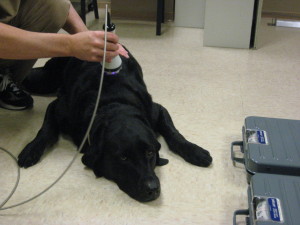 Rex, a 135 pound German Shepherd has suffered from a limp and joint pain for the past two years. This man’s best friend, 70 in dog years, 10 in people years, needed treatment for his arthritic pain. But rather than opting for traditional pills or surgery, the owner tried a new, seemingly magical, laser therapy from the local veterinary clinic. After the procedure, Rex’s limp and overall activity and happiness improved almost immediately after the first laser treatment.
Rex, a 135 pound German Shepherd has suffered from a limp and joint pain for the past two years. This man’s best friend, 70 in dog years, 10 in people years, needed treatment for his arthritic pain. But rather than opting for traditional pills or surgery, the owner tried a new, seemingly magical, laser therapy from the local veterinary clinic. After the procedure, Rex’s limp and overall activity and happiness improved almost immediately after the first laser treatment.
Cold laser therapy is a noninvasive procedure that uses light to stimulate cell regeneration and increase blood circulation. Cold laser therapy treats the surface of the skin, while hot laser treatments affect deeper tissues. Cold laser therapy is still a relatively new concept that is being used more recently to treat dogs with arthritis, tendon, or soft tissue injuries and to promote wound healing.
The lasers are nothing more than a beam of light that travels at a certain frequency that allows the laser to generate heat and penetrate tissue. This process, know as photo-biotherapy stimulates protein synthesis and cell metabolism, which improves cell health and functionality. The procedure done at the correct wavelength, reduces pain signals and decreases nerve sensitivity. Endorphins are also released which are natural pain killlers.
Dogs find laser therapy relaxing and tend to enjoy the treatment, so there is no need for sedation or anesthesia. That means that treatment can be applied multiple times a day or a number of times per week. A typical laser therapy session can take as little as eight to ten minutes on a small dog or cat, or about a half hour for bigger dogs with more arthritic areas. There is no need to shave or clip the area to be treated.
If you have a dog with arthritis, you can expect to start laser treatment with two to three sessions per week, then decrease sessions to once a week, then once every two weeks. The number of therapy sessions are based on the response of the animal. If the arthritis is more advanced, then more sessions would be needed.
After laser therapy, pet owner’s might see their pet go upstairs more often, play with a ball he’s not picked up in months or go back to getting on the couch for his nightly snuggle with family members. And, when dogs have better mobility, medications can often be reduced. The cold lasers won’t cause any unwanted side effects and will not burn your pet’s skin. Cost generally only runs about $25 to $45 per session which is dependent on the length of the session.
Laser therapy improves the quality of a pet’s life as well as the life of its owner, because if your pet is happy, you are happy. Contact us for more information or to schedule an appointment!
June Is Adopt A Cat Month
 Is there anything sweeter than a kitten? Hmm…nope! Like any life decision, adopting a cat is a choice that should not be taken lightly. There are a number of things to consider, such as your own needs and expectations.
Is there anything sweeter than a kitten? Hmm…nope! Like any life decision, adopting a cat is a choice that should not be taken lightly. There are a number of things to consider, such as your own needs and expectations.
If you think you are ready for paw prints on countertops, cat fur on virtually everything and ready for litter box duty, be sure to consider the following before making a final decision. More goes into the kitten’s care than plopping down food and setting up a litter box.
1. Research Cats Before Adopting
It’s essential to spend time alone with any cat you’re adopting. You might do all your research and know exactly what you want, but if the cat you want doesn’t want you, there may be problems ahead. Getting to know each cat on a personal level before you make a choice can lead to a more positive adoption experience for all involved. You also may want to consider taking home two. Cats require exercise, mental stimulation, and social interaction. Two cats can provide this for each other. Plus they’ll provide more benefits to you. Cats’ purring has been shown to soothe humans as well as themselves–and they have an uncanny ability to just make you smile. A great place to start your search is online. Sites like Petfinder.com let you search numerous shelters in your are simultaneously to help narrow your search and more quickly find the match that’s right for you and your new feline friend.
2. Purr-sonality Matters
Just as we each have our own personality, so do cats. It is important to pick a cat that has a personality that will fit your needs. For example, if you’re looking for a lap cat, you’ll want to choose a cat or kitten that is comfortable being held and pet. If you want a cat that is playful, you’ll want to choose one that responds well to you and doesn’t slink away to nap in the corner. in general, cats with long hair and round heads and bodies are more easygoing than lean cats with narrow heads and short hair, who are typically more active.
3. Choose a Cat Whose Age Matches Your Lifestyle
Kittens may be cute, but they also require a lot of initial training and commitment, and need to be supervised to ensure they’re using the litter box, not clawing or chewing on household plants. Make sure you have the time to commit to training a kitten.
Adult cats are usually housebroken, have a routine of their own, normally don’t require the training that comes with a new kitten, and are usually not as demanding as their younger counterparts.

4. Ask About Overall Cat Health
You should always inquire as to the health of the pet you are thinking about adopting and if it has been spayed or neutered. You should check with the shelter staff about vaccinations and if there are any health issues you need to know about. Ask for a vaccination record at the time of adoption so you can show it to your veterinarian when your pet has its first examination.
5. Do See a Veterinarian ASAP
Kittens seem indestructible but get sick easily. A veterinarian’s early diagnosis improves the chances of a speed recovery. Screening tests and preventive care –vaccinations, flea prevention, worm medications –save lives and ensure your kitten grows to healthy adulthood. You will want to take any medical records you received from the adoption center along with your pet to your first visit so the veterinary staff can pet your cat and tell you that you’ve chosen the most beautiful cat ever.
Regardless of the cat you select, adopting isn’t like purchasing a household appliance or a piece of jewelry–this is a real living, breathing, and emotional being. So this means that you’re committing to her throughout her lifetime–which can mean up to twenty years in age or more.
Contact our office if you have more questions!

